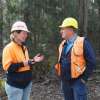
Salinity: Identify and respond with trees
Posted 28 April 2024
Plantation planning Species, sites and planting On-farm benefits Tree Alliance
Salinity is where excess salts accumulate in soils and water. On farms, it affects productivity for crops and pastures. Farmers may spot tell-tale signs of salinity on their land, including bare patches of grass or unhealthy plants. Strategic tree planting can help prevent and address salinity before it becomes unmanageable.
We spoke to Julie Finnigan, Technical Agronomist at Serve Ag, about why addressing salinity is crucial for farmers.
What is salinity?
Salinity happens on farms when water from rain or irrigation leaks downwards. It can cause watertables to rise, or develop perched watertables within layers of clay. If salts are present, the excess salts can move upwards towards the soil surface. If unmanaged, salinity can significantly reduce landscape health and productivity.
Julie Finnigan is a salinity expert who has worked in Tasmanian agriculture for 30 years to support farmers to boost the productivity of their land. She says salinity is easier to prevent than to treat – and explains how trees can help.
"Salinity is the presence of salts in soils and water, primarily sodium chloride here in Tasmania," says Julie. "It’s the presence of these salts at levels too high for plants to grow, and different plants have different tolerance levels
"Salinity in Tassie is very different from the mainland. It occurs in regions with low rainfall and high evaporation rates, and that coincides with regions that also have irrigation schemes. So it’s not a blanket issue. It occurs in specific, identifiable zones.
"If you’ve got shallow soils, low-lying areas or gullies, drainage alone may be insufficient and salts can accumulate over time.
"If you don’t manage it, you can lose productive land. And that area affected can continue to get worse in terms of increasing salinity levels and expansion of land affected over time. That means loss of income from agriculture or biodiversity, and then there’s the environmental impacts. So there’s a really big loss for landowners if salinity isn’t addressed.’

Prevention is better than cure
Detecting issues through monitoring and taking action early is the best treatment for salinity. There are ways farmers can monitor their land for early warning signs.
"It’s much easier to prevent salinity occurring than to try and remediate it," says Julie, "so the first aspect is that you need to be aware of it to manage it accordingly.
"There are signs and symptoms you can look for. Quite often, there’s what we call indicator species that grow in an area that’s affected. Or sometimes it might be a bare patch of soil or areas of patchiness, or you might actually see the salt crystalising on the surface.
"With trees, you might have a shelterbelt growing uniformly and then all of a sudden, a patch of trees decline in health and productivity.
"You can also look at LISTmap and pull up some of the regions that are likely to have salinity. You can start to look and piece it together. Growers can also test their water or soil, either by taking it to a laboratory and getting it tested or getting a test to do themselves."
How trees can help
Trees are vital tools to address salinity. Roots intercept rainfall and uptake water from the ground. This reduces risk of salinisation. But understanding where best to place trees is important.
"Tree planting is really beneficial for salinity management," says Julie. "It doesn’t pay to plant trees in zones where there’s salinity, because ultimately the trees don’t perform at their best.
"But if you can plant trees in upper recharge or mid-slope areas – and intercept and use that water where it falls, you can prevent the movement of excess water into lower lying saline areas.
"So strategic planting of trees, integrated on properties, can be very beneficial.
"Lots of people think Tassie doesn’t have salt, but actually we do,’ says Julie, ‘a lot of work has been done to raise awareness of salinity here in Tasmania.
"I encourage growers to look for information. There are lots of tools available to assist people to identify salinity and implement management options. And there are professionals available to help where needed."
Find out more about salinity with the Tree Alliance knowledge hub. Go to www.treealliance.com.au and visit the topic, On-farm benefits.






